Natural Disasters. The Four seasons in art презентация
Natural Disasters. The Four seasons in art презентация
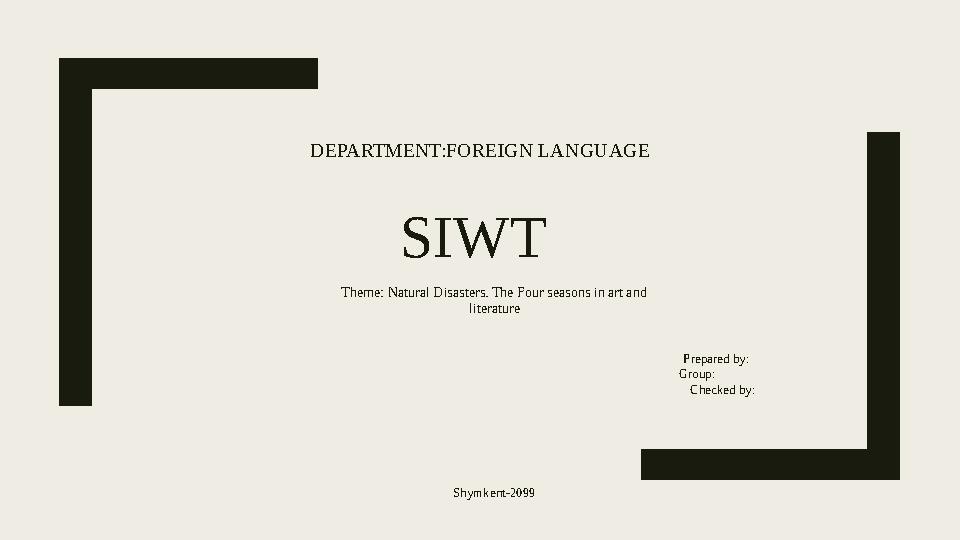

#1 слайд
DEPARTMENT:FOREIGN LANGUAGE
SIWT
Theme: Natural Disasters. The Four seasons in art and
literature
Prepared by:
Group:
Checked by:
Shymkent-20 99
1 слайд
DEPARTMENT:FOREIGN LANGUAGE SIWT Theme: Natural Disasters. The Four seasons in art and literature Prepared by: Group: Checked by: Shymkent-20 99

#2 слайд
Plan:
Introduction:
Natural disasters
Main part:
Storm,tornado,flood,etc.
Conclusion :
Used literature :
2 слайд
Plan: Introduction: Natural disasters Main part: Storm,tornado,flood,etc. Conclusion : Used literature :
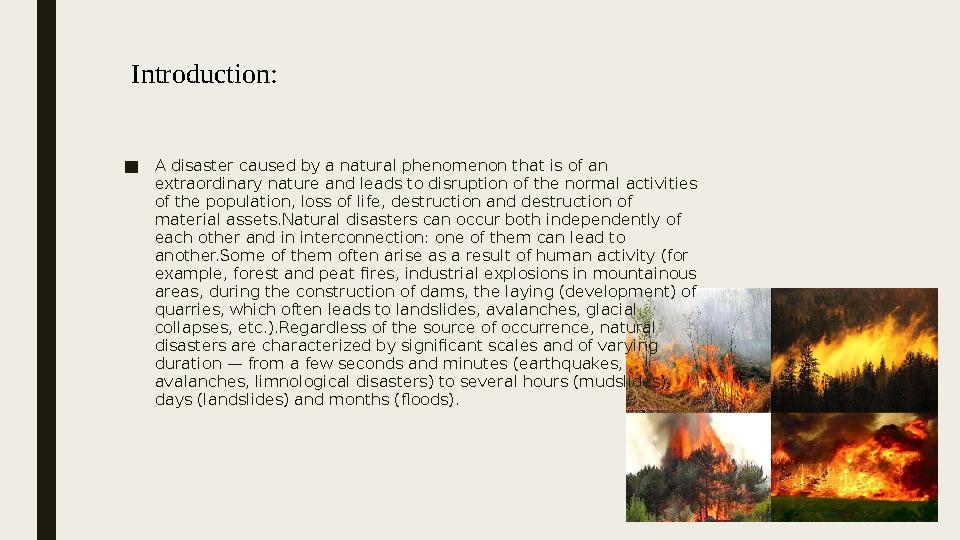
#3 слайд
■
A disaster caused by a natural phenomenon that is of an
extraordinary nature and leads to disruption of the normal activities
of the population, loss of life, destruction and destruction of
material assets.Natural disasters can occur both independently of
each other and in interconnection: one of them can lead to
another.Some of them often arise as a result of human activity (for
example, forest and peat fires, industrial explosions in mountainous
areas, during the construction of dams, the laying (development) of
quarries, which often leads to landslides, avalanches, glacial
collapses, etc.).Regardless of the source of occurrence, natural
disasters are characterized by significant scales and of varying
duration — from a few seconds and minutes (earthquakes,
avalanches, limnological disasters) to several hours (mudslides),
days (landslides) and months (floods).Introduction:
3 слайд
■ A disaster caused by a natural phenomenon that is of an extraordinary nature and leads to disruption of the normal activities of the population, loss of life, destruction and destruction of material assets.Natural disasters can occur both independently of each other and in interconnection: one of them can lead to another.Some of them often arise as a result of human activity (for example, forest and peat fires, industrial explosions in mountainous areas, during the construction of dams, the laying (development) of quarries, which often leads to landslides, avalanches, glacial collapses, etc.).Regardless of the source of occurrence, natural disasters are characterized by significant scales and of varying duration — from a few seconds and minutes (earthquakes, avalanches, limnological disasters) to several hours (mudslides), days (landslides) and months (floods).Introduction:

#4 слайд
Tornado
■
A tornado is an atmospheric vortex
that occurs in a cumulonimbus
(thunderstorm) cloud and spreads
down, often to the very surface of
the earth, in the form of a cloud
sleeve or trunk with a diameter of
tens and hundreds of meters. The
development of a tornado from a
cloud distinguishes it from some
externally similar and also different
in nature phenomena.
4 слайд
Tornado ■ A tornado is an atmospheric vortex that occurs in a cumulonimbus (thunderstorm) cloud and spreads down, often to the very surface of the earth, in the form of a cloud sleeve or trunk with a diameter of tens and hundreds of meters. The development of a tornado from a cloud distinguishes it from some externally similar and also different in nature phenomena.
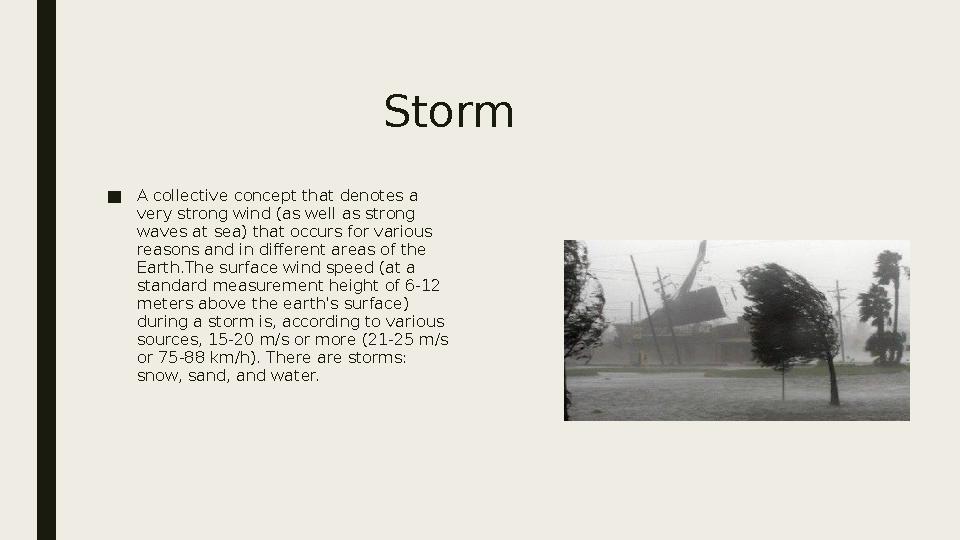
#5 слайд
■
A collective concept that denotes a
very strong wind (as well as strong
waves at sea) that occurs for various
reasons and in different areas of the
Earth.The surface wind speed (at a
standard measurement height of 6-12
meters above the earth's surface)
during a storm is, according to various
sources, 15-20 m/s or more (21-25 m/s
or 75-88 km/h). There are storms:
snow, sand, and water. Storm
5 слайд
■ A collective concept that denotes a very strong wind (as well as strong waves at sea) that occurs for various reasons and in different areas of the Earth.The surface wind speed (at a standard measurement height of 6-12 meters above the earth's surface) during a storm is, according to various sources, 15-20 m/s or more (21-25 m/s or 75-88 km/h). There are storms: snow, sand, and water. Storm
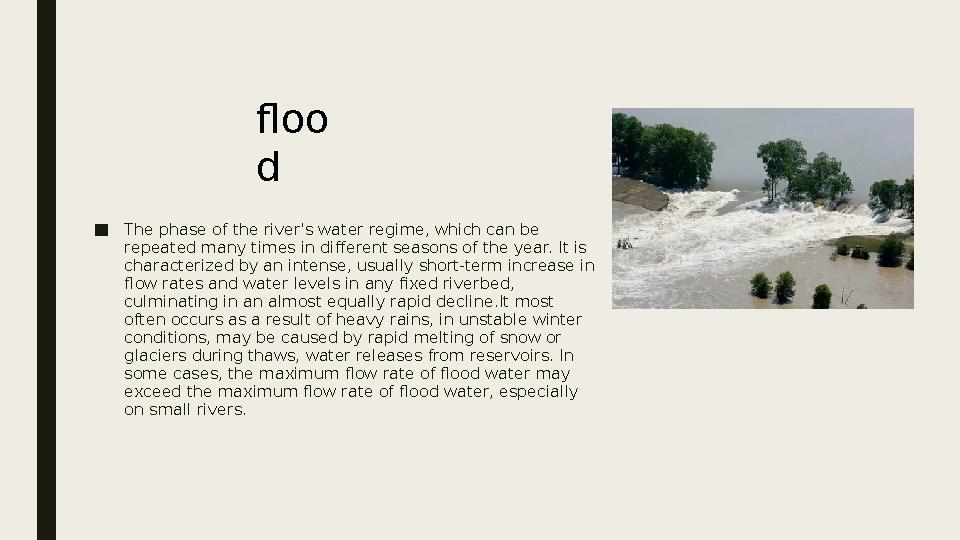
#6 слайд
■
The phase of the river's water regime, which can be
repeated many times in different seasons of the year. It is
characterized by an intense, usually short-term increase in
flow rates and water levels in any fixed riverbed,
culminating in an almost equally rapid decline.It most
often occurs as a result of heavy rains, in unstable winter
conditions, may be caused by rapid melting of snow or
glaciers during thaws, water releases from reservoirs. In
some cases, the maximum flow rate of flood water may
exceed the maximum flow rate of flood water, especially
on small rivers. floo
d
6 слайд
■ The phase of the river's water regime, which can be repeated many times in different seasons of the year. It is characterized by an intense, usually short-term increase in flow rates and water levels in any fixed riverbed, culminating in an almost equally rapid decline.It most often occurs as a result of heavy rains, in unstable winter conditions, may be caused by rapid melting of snow or glaciers during thaws, water releases from reservoirs. In some cases, the maximum flow rate of flood water may exceed the maximum flow rate of flood water, especially on small rivers. floo d
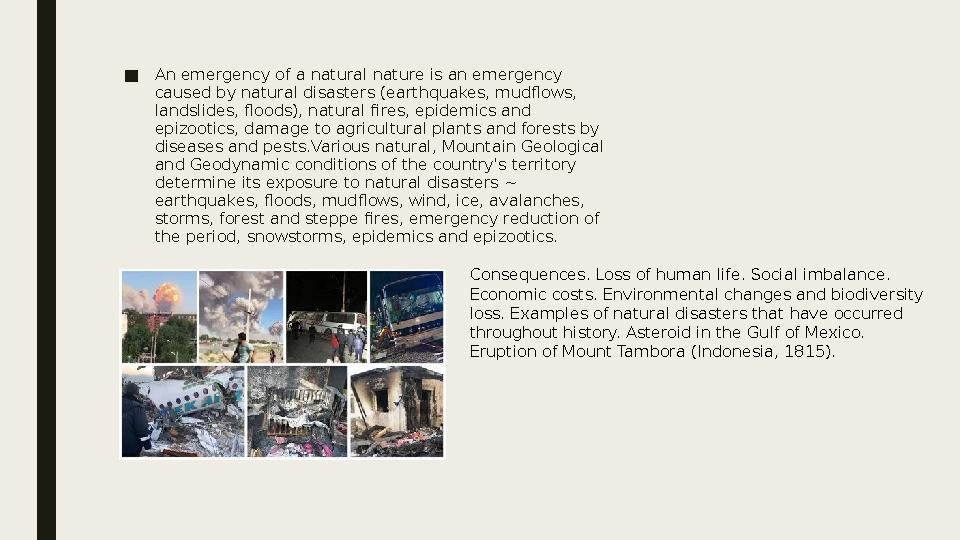
#7 слайд
■
An emergency of a natural nature is an emergency
caused by natural disasters (earthquakes, mudflows,
landslides, floods), natural fires, epidemics and
epizootics, damage to agricultural plants and forests by
diseases and pests.Various natural, Mountain Geological
and Geodynamic conditions of the country's territory
determine its exposure to natural disasters ~
earthquakes, floods, mudflows, wind, ice, avalanches,
storms, forest and steppe fires, emergency reduction of
the period, snowstorms, epidemics and epizootics.
Consequences. Loss of human life. Social imbalance.
Economic costs. Environmental changes and biodiversity
loss. Examples of natural disasters that have occurred
throughout history. Asteroid in the Gulf of Mexico.
Eruption of Mount Tambora (Indonesia, 1815).
7 слайд
■ An emergency of a natural nature is an emergency caused by natural disasters (earthquakes, mudflows, landslides, floods), natural fires, epidemics and epizootics, damage to agricultural plants and forests by diseases and pests.Various natural, Mountain Geological and Geodynamic conditions of the country's territory determine its exposure to natural disasters ~ earthquakes, floods, mudflows, wind, ice, avalanches, storms, forest and steppe fires, emergency reduction of the period, snowstorms, epidemics and epizootics. Consequences. Loss of human life. Social imbalance. Economic costs. Environmental changes and biodiversity loss. Examples of natural disasters that have occurred throughout history. Asteroid in the Gulf of Mexico. Eruption of Mount Tambora (Indonesia, 1815).
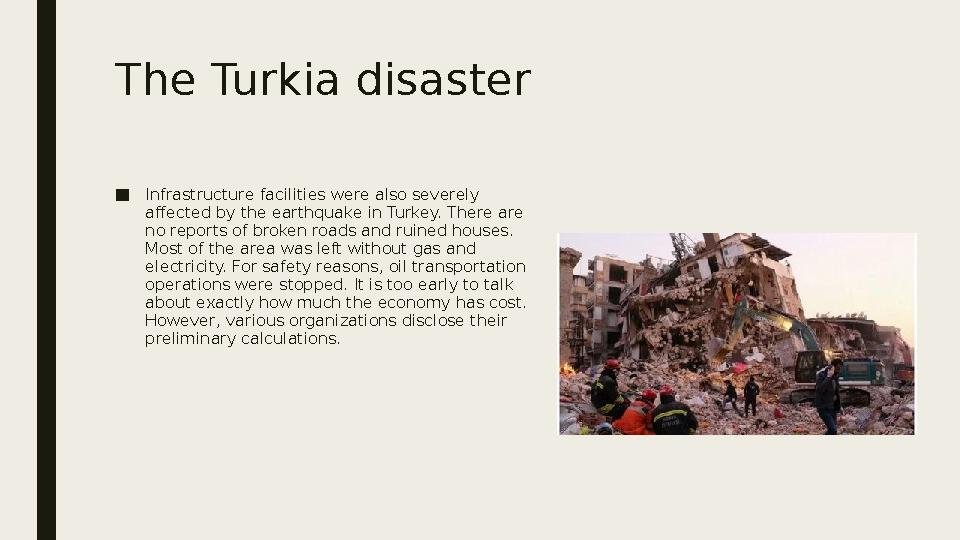
#8 слайд
The Turkia disaster
■
Infrastructure facilities were also severely
affected by the earthquake in Turkey. There are
no reports of broken roads and ruined houses.
Most of the area was left without gas and
electricity. For safety reasons, oil transportation
operations were stopped. It is too early to talk
about exactly how much the economy has cost.
However, various organizations disclose their
preliminary calculations.
8 слайд
The Turkia disaster ■ Infrastructure facilities were also severely affected by the earthquake in Turkey. There are no reports of broken roads and ruined houses. Most of the area was left without gas and electricity. For safety reasons, oil transportation operations were stopped. It is too early to talk about exactly how much the economy has cost. However, various organizations disclose their preliminary calculations.

#9 слайд
"Rivers of the soul«
■
In 1931, China experienced the greatest
flood. The Yangtze River ranks third among
the largest rivers, with about 700 rivers
flowing into it. Every year, during
precipitation, water overflows and
overflows. In August 1931, the Yangtze
River and the neighboring Yellow River
burst, joining a powerful stream and
breaking through the dams. This led to a
global flood. They destroyed everything in
their path and washed away 16 provinces of
China, that is, 300,000 hectares.
9 слайд
"Rivers of the soul« ■ In 1931, China experienced the greatest flood. The Yangtze River ranks third among the largest rivers, with about 700 rivers flowing into it. Every year, during precipitation, water overflows and overflows. In August 1931, the Yangtze River and the neighboring Yellow River burst, joining a powerful stream and breaking through the dams. This led to a global flood. They destroyed everything in their path and washed away 16 provinces of China, that is, 300,000 hectares.

#10 слайд
Used literature:
1. BridgeWorks. (2019). Generational Communication Differences. Retrieved from
https://www.generations.com/resources/generational-communication-differences/
2. Deloitte. (2016). The Deloitte Millennial Survey 2016. Retrieved from
https://www.deloitte.com/content/dam/Deloitte/global/Documents/About-Deloitte/gx-wef-2016-
millennial-survey-executivesummary.pdf
3. Harvard Business Review. (2017). How Reverse Mentoring Can Benefit Your Company. Retrieved
from https://hbr.org/2017/11/how-reverse-mentoring-benefits-both-mentors-and-mentees
4. McKinsey & Company. (2020). Diversity wins: How inclusion matters. Retrieved from
https://www.mckinsey.com/business-functions/organization/our-insights/diversity-wins-how-inclusion-
matters
5. PwC. (2019). Bridging the Gap: How to Drive Employee Engagement through Diversity and Inclusion.
Retrieved from https://www.pwc.com/us/en/services/human-capital/library/diversity-inclusion-
workplace-survey.html
10 слайд
Used literature: 1. BridgeWorks. (2019). Generational Communication Differences. Retrieved from https://www.generations.com/resources/generational-communication-differences/ 2. Deloitte. (2016). The Deloitte Millennial Survey 2016. Retrieved from https://www.deloitte.com/content/dam/Deloitte/global/Documents/About-Deloitte/gx-wef-2016- millennial-survey-executivesummary.pdf 3. Harvard Business Review. (2017). How Reverse Mentoring Can Benefit Your Company. Retrieved from https://hbr.org/2017/11/how-reverse-mentoring-benefits-both-mentors-and-mentees 4. McKinsey & Company. (2020). Diversity wins: How inclusion matters. Retrieved from https://www.mckinsey.com/business-functions/organization/our-insights/diversity-wins-how-inclusion- matters 5. PwC. (2019). Bridging the Gap: How to Drive Employee Engagement through Diversity and Inclusion. Retrieved from https://www.pwc.com/us/en/services/human-capital/library/diversity-inclusion- workplace-survey.html

шағым қалдыра аласыз
















